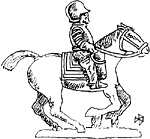 Well, all of us renaissance gamers who have been regarding DBA/DBM players with green eyed envy now have our very own set of rules....De Bellis Renationis (DBR). It is not a rewrite of DBA/M, but something on its own. This is not the place for a review, of which I am sure there will be many. I want to use these rules to fight battles, and this is how I (intend to) do it....
Well, all of us renaissance gamers who have been regarding DBA/DBM players with green eyed envy now have our very own set of rules....De Bellis Renationis (DBR). It is not a rewrite of DBA/M, but something on its own. This is not the place for a review, of which I am sure there will be many. I want to use these rules to fight battles, and this is how I (intend to) do it....
The DBR army lists offer the possibility to make 100 point armies, that is, about 10-15 elements (or 40 elements if you want to run Incas). Having looked through the first (and so far only) army lists book, together with the Irregular Miniatures 6mm catalogue, it works out that the average is inexpensive. My problem always was that I got bored with only using English Civil War types, so here is a golden opportunity to use some highly obscure soldiers. A quick trawl through my soldier storage cabinet suggested that I could put together about 8 armies of various Western European powers. All I needed was the map, and some campaign rules.
And then it struck me, or at least, Lone Warriors 109,110 and 112 did. Taking the ideas of blob maps from Steve Foster (LW 112) reminded me of an excellent board game, Machiavelli, set in the Italian wars. Although not miniatures based, it too used blobs for provinces, and the different powers started with buffer states between them. The DBA system as "soloised" by Ian Duncan (LW 110) permits diplomacy without tears and Paul Grace's national morale system (LW 109) can modify it to tell countries when to give up, or whatever.
To start off with, a map is required. This really just has to be a series of blobs. The number of provinces required depends on the number of armies and nations you want or have. It is a good idea to put some sort of vital strategic provinces in, say between two dumbbell type parts of Blobania. This will automatically give reasons to move there when otherwise armies may just wander aimlessly. It is also a good idea to have a number of provinces that is easily divisible by ten, so when you get to the next stage you don't have to perform mental acrobatics.
Random Distribution
The next stage is to randomly distribute your nations into their home provinces. This is best done using dice (I used D100s for a 50 province map). A bit of common sense is also required as your nations will be very vulnerable to attack in the early stages and its not a good idea to have nations next to each other unless you want some of your troops to only make it out of the box once. That done, the diplomacy matrix is set up as per Solo DBA, with one card drawn for each nation/nation interaction. National morale is set to zero, or whatever seems appropriate to you. If you want a historical match up, then you can always use islands rather than continents, one island to each sub period.
Each province a nation owns will permit him to raise 1 x 100 point army. Thus nations start with one army only. This may invade neighboring provinces so long as the national morale permits (i.e. it i· above -4) and the province is unoccupied. If the province is occupied, then if the owning power is an ally, it may not be invaded, if the owner is neutral, it becomes hostile and if hostile, that's war! If the province has an army then a battle is fought as per the rules. In order to invade a hostile or neutral province, the national morale must be >3.
National morale is affected by such things as capturing provinces (+1), declaring war (+1), having war declared (-1), and so on, whatever modifiers you wish to use. Three turns make a year, and diplomacy cards are drawn at the beginning of each turn. At the end of a year, count the number of provinces owned and add or subtract the relevant number of armies from a nations total. If the home province is lost, the nation is defeated and overrun.
 As time goes by, a large number of armies may be collected by a single nation, and they will wish to support each other. In Machiavelli, two armies cooperating count as a strength 2 army. Here, however, in order to keep sizes under control, I propose that the first supporting army contributes an extra 50 points to the supported, the second 25 points and so on. The same could also be used for ally armies supporting. Thus the size of a deployed army stays within reasonable constraints.
As time goes by, a large number of armies may be collected by a single nation, and they will wish to support each other. In Machiavelli, two armies cooperating count as a strength 2 army. Here, however, in order to keep sizes under control, I propose that the first supporting army contributes an extra 50 points to the supported, the second 25 points and so on. The same could also be used for ally armies supporting. Thus the size of a deployed army stays within reasonable constraints.
Well, that's the basic system. A blob map can be drawn and nations distributed in under an hour, so a campaign can be well underway in an evening. The map can be scrawled upon hatched, colored, and eventually discarded when a superpower appears. Many subtleties can be introduced, such as navies, siege trains (guns are generally too expensive for 100 point DBR armies), ports, fortifications, spies and the like. I haven't done this, but having just purchased both Tony Bath's and Charles Grant's campaign books, I dare say I might.
Other things might also be added. In mind I have things like, well, it was actually rather hard for armies to find each other in those days. Another board game of my acquaintance had a table for matching cavalry points, to see if the attacker actually found the invader. Thus a struggle could be developed over a number of moves with an army unable to pin down a fleeter footed opponent. Army orders, such as "attack", "hold" or "skirmish" can be introduced, where a skirmishing army will attempt to withdraw rather than fight. Characterization too could be added, and relations between the commanders and governments could be strained. Machiavelli has rules for bribery, corruption, raising extra and extra-strong armies, plague, famine and assassination. The possibilities are endless, and I'm still working out how to include some of them.
Well, these are my thoughts on the subject at present. I'll let you know of any developments, and would be very pleased to hear of any suggestions. Currently, plans are afoot for every European army in army book one...
Back to Table of Contents -- Lone Warrior #113
Back to Lone Warrior List of Issues
Back to MagWeb Magazine List
© Copyright 1996 by Solo Wargamers Association.
This article appears in MagWeb (Magazine Web) on the Internet World Wide Web.
Other military history articles and gaming articles are available at http://www.magweb.com
